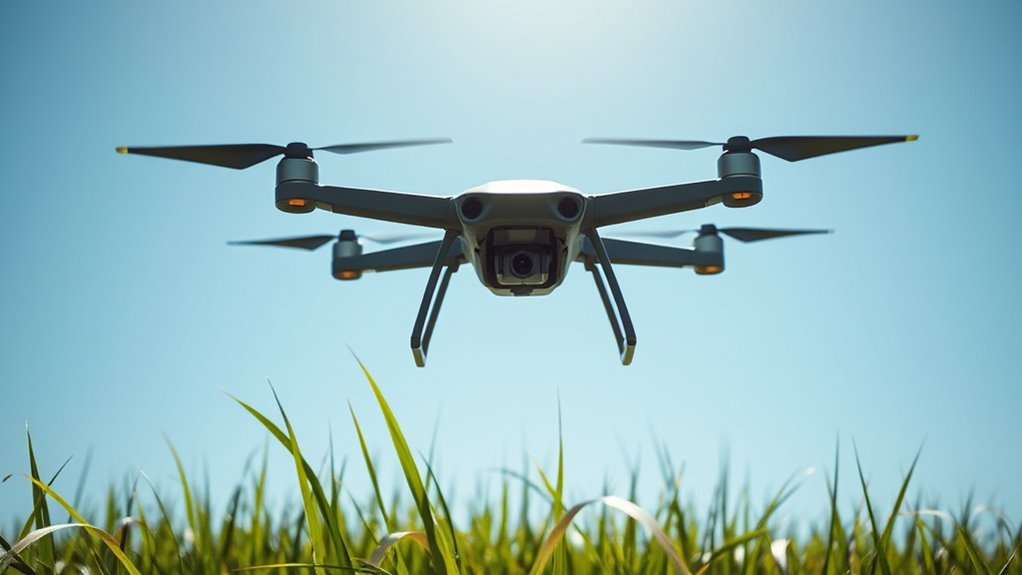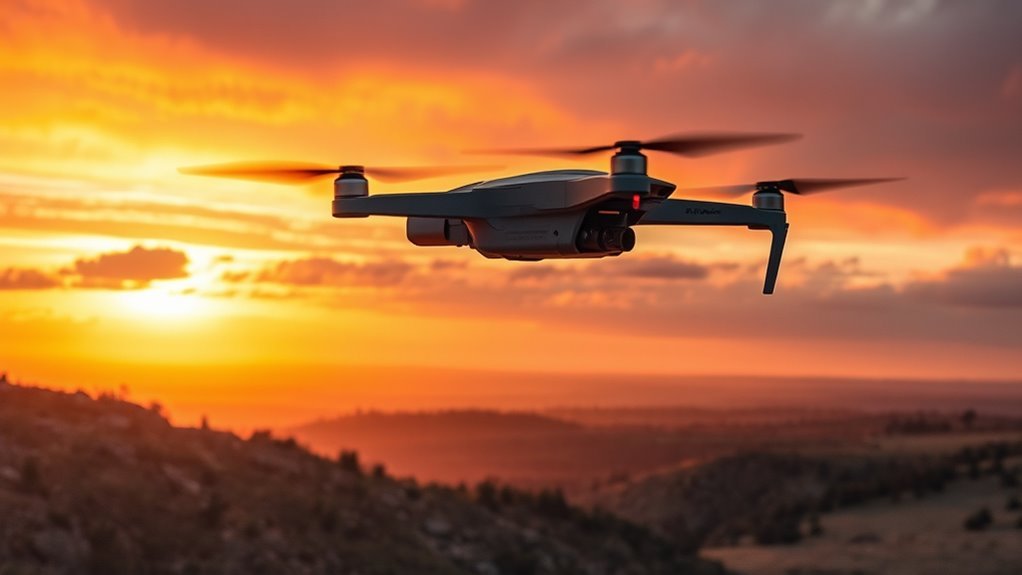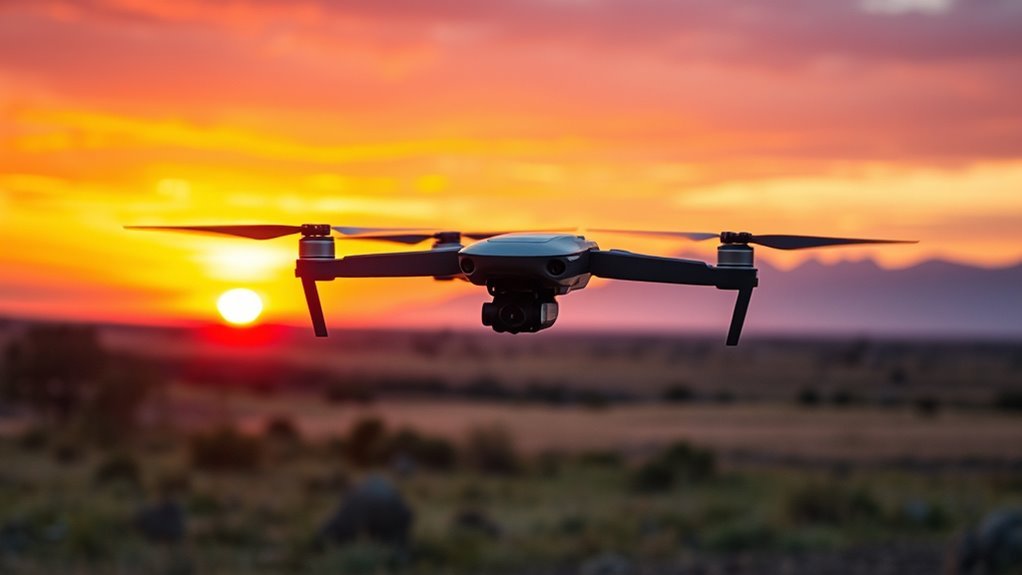You control your drone’s speed through a balance of aerodynamic design, motor power, propeller dynamics, weight distribution, and material quality. Efficient shapes reduce drag, while motor torque and propeller pitch impact thrust and acceleration. Battery capacity limits sustained power output. Environmental factors like altitude and wind also influence performance, alongside software algorithms adjusting flight control responsiveness. Understanding these elements’ interplay reveals how to optimize velocity and efficiency beyond just hardware specs.
Aerodynamic Design and Shape

Although several factors influence drone flight speed, aerodynamic design and shape play a critical role in minimizing drag and optimizing airflow. You need to understand that the drone’s exterior contours directly affect aerodynamic lift and drag reduction. Smooth, streamlined surfaces reduce turbulent airflow, lowering drag forces that impede speed. By maximizing aerodynamic lift efficiently, the drone sustains stable flight with less energy expenditure, allowing higher velocity. Angular or bulky profiles increase drag, forcing motors to work harder, limiting top speed and flight duration. As you seek freedom in flight, prioritizing a design that balances minimal frontal area and optimized airflow paths becomes essential. This precision in shape engineering enables your drone to cut through air with reduced resistance, revealing superior speed potential without compromising control.
Weight and Payload Capacity

You’ll notice that a drone’s total weight directly affects its acceleration and top speed due to increased inertia. Adding payload increases the load on motors, reducing efficiency and limiting maximum velocity. Understanding how weight and payload interact is essential for optimizing flight performance.
Impact of Drone Weight
When carrying heavier payloads, a drone’s flight speed is directly influenced by its overall weight, as increased mass demands more power to maintain velocity and stability. You’ll notice that drone stability heavily depends on precise weight distribution; uneven loads can reduce aerodynamic efficiency and cause erratic flight behavior. Optimizing this balance is vital for preserving speed without compromising control.
| Weight (grams) | Required Power (Watts) | Approximate Max Speed (km/h) |
|---|---|---|
| 500 | 150 | 60 |
| 750 | 210 | 50 |
| 1000 | 280 | 42 |
| 1250 | 360 | 35 |
| 1500 | 450 | 28 |
Managing weight and distribution lets you access your drone’s true performance potential.
Payload Influence on Speed
Since a drone’s payload capacity directly limits the maximum weight it can carry, understanding how additional payload affects flight speed is crucial for operational efficiency. The payload type greatly influences aerodynamic drag and power consumption; heavier or bulkier payloads increase resistance, reducing maximum velocity. Furthermore, payload distribution is critical—uneven weight can destabilize flight dynamics, forcing the drone to expend more energy to maintain control, thereby lowering speed. You’ll need to enhance both payload type and its distribution to preserve agility and speed. Efficient payload management guarantees the drone operates within its design limits, maintaining ideal thrust-to-weight ratios. By carefully selecting lightweight payloads and balancing them evenly, you can maximize flight speed and extend operational freedom without compromising safety or performance.
Motor Power and Efficiency

You need to contemplate how motor torque directly influences acceleration and sustained flight speed in drones. The power-to-weight ratio is a critical metric that determines how effectively your drone converts motor output into forward velocity. Additionally, motor efficiency impacts energy consumption, which in turn affects flight duration and speed consistency.
Motor Torque Impact
Motor torque plays an essential role in determining a drone’s flight speed by directly influencing the motor’s power output and overall efficiency. When you analyze motor performance, the torque curve reveals how torque varies with RPM, impacting acceleration and top speed. A motor with a flat torque curve maintains consistent thrust, allowing your drone to accelerate smoothly and sustain higher velocities without efficiency loss.
| Torque (Nm) | RPM | Efficiency (%) |
|---|---|---|
| 0.12 | 5000 | 85 |
| 0.10 | 7000 | 88 |
| 0.08 | 9000 | 82 |
Optimizing motor torque guarantees your drone maximizes power delivery while conserving energy, granting you the freedom to fly faster and longer.
Power-to-Weight Ratio
A drone’s power-to-weight ratio critically determines its acceleration, agility, and maximum flight speed by balancing the motor’s power output against the drone’s overall mass. When you optimize power efficiency, the motor converts electrical energy into thrust generation more effectively, enabling quicker responses and sustained high speeds. A higher ratio means the motors produce more thrust relative to weight, allowing the drone to overcome drag and gravitational forces faster. If the motors are underpowered or inefficient, the drone struggles to accelerate or maintain velocity, limiting freedom in maneuvering. Consequently, selecting motors with superior power efficiency and ensuring the drone’s weight is minimized without compromising structural integrity directly enhances flight performance. This balance is essential for maximizing speed while maintaining control and responsiveness in dynamic flight conditions.
Energy Efficiency Effects
Although raw power is essential, the efficiency with which that power is converted into thrust directly impacts a drone’s flight speed and endurance. When selecting a motor, you need to take into account not just its maximum output but how effectively it transforms energy from your drone’s energy source into mechanical motion. Higher-efficiency motors reduce energy loss as heat, allowing more power to be allocated to propulsion. This directly extends flight duration while maintaining ideal speed. Inefficient motors demand more power for the same thrust, draining your energy source faster and limiting both how far and how fast you can fly. By optimizing motor power and efficiency, you guarantee that your drone achieves maximum velocity without compromising freedom in the air due to premature battery depletion.
Propeller Size and Pitch
When optimizing drone flight speed, understanding how propeller size and pitch influence performance is essential. Propeller dynamics dictate how efficiently your drone converts motor power into thrust generation, directly impacting acceleration and top speed. Larger propellers displace more air, increasing thrust, but also add drag, potentially reducing agility. Conversely, smaller propellers reduce drag but may lack sufficient thrust for high-speed flight. Pitch, the angle of the blades, affects how far the drone moves per rotation—higher pitch means greater forward movement but requires more power and can strain motors if mismatched. Balancing size and pitch optimizes thrust generation without overloading your system, enabling smoother acceleration and sustained speed. Mastering these variables gives you the freedom to tailor your drone’s performance to your flying style and mission demands.
Battery Life and Power Output
Optimizing propeller size and pitch sets the stage for how effectively your drone uses its power source. Battery life and power output are critical in determining your drone’s maximum speed and flight duration. Advanced battery technology, such as high-capacity lithium-polymer cells, delivers greater energy density, enabling sustained high power output without rapid voltage drops. Efficient power management systems regulate current flow, preventing overheating and ensuring consistent motor performance at peak speeds. You must balance battery weight against capacity; heavier batteries offer extended flight time but reduce acceleration and top speed. Additionally, real-time monitoring of battery health and power consumption allows you to optimize flight plans, maximizing speed while preserving energy reserves. Mastering these factors grants you the freedom to push your drone’s performance envelope with confidence.
Environmental Conditions and Weather
Since drones operate within dynamic atmospheric environments, understanding how environmental conditions and weather impact flight speed is essential. Wind resistance directly challenges your drone’s propulsion, reducing speed and maneuverability, especially in gusty conditions. Temperature effects alter battery efficiency and motor performance, while humidity levels can influence air density and aerodynamic drag. Precipitation impact, including rain or snow, not only slows your drone but risks system damage. Visibility conditions affect navigation safety, requiring adjustments in speed to comply with flight regulations. Atmospheric pressure variations modify lift capabilities, influencing ideal speed ranges. Terrain type and urban obstacles demand constant speed modulation to prevent collisions. Additionally, wildlife interference can necessitate evasive maneuvers. Mastering these factors lets you push your drone’s limits while maintaining control and freedom in complex environments.
Flight Controller and Software Optimization
Although environmental factors set the stage for your drone’s performance, the flight controller and software fine-tuning play a critical role in translating those conditions into precise speed control. The flight algorithms embedded in the controller dictate how effectively your drone processes sensor inputs and adjusts motor outputs. Real time processing guarantees immediate response to dynamic changes in drone navigation, maintaining peak speed and stability. Software updates refine these algorithms, enhancing control responsiveness and correcting inefficiencies. Efficient data transmission between sensors, the controller, and actuators minimizes latency, allowing your drone to react swiftly to commands and environmental shifts. By refining these technical elements, you release your drone’s true velocity potential, granting you the freedom to push boundaries while maintaining precise, reliable control at high speeds.
Material Quality and Build Sturdiness
Beyond the software and control systems, the physical characteristics of your drone considerably influence its flight speed. Material durability and frame rigidity are critical. A sturdy frame reduces flex during high-speed maneuvers, maintaining aerodynamic efficiency and control responsiveness. Conversely, poor material quality can lead to structural failures or increased drag, hindering velocity.
Key factors include:
Key factors include material durability, frame rigidity, weight-to-strength ratio, aerodynamic profile, and joint quality.
- Material Durability: Resists wear and tear, ensuring consistent performance.
- Frame Rigidity: Minimizes deformation under stress for stable flight.
- Weight-to-Strength Ratio: Balances toughness with lightweight design to maximize acceleration.
- Aerodynamic Profile: Smooth, rigid surfaces reduce air resistance.
- Joint and Fastener Quality: Prevents looseness that can cause instability.
Investing in high-quality materials lets you push your drone’s speed potential without compromising reliability.
Altitude and Air Density Effects
When you increase altitude, the air density decreases, which directly impacts your drone’s flight speed and performance. Lower air density reduces the amount of lift generated by the rotors, forcing your drone to work harder to maintain altitude. This altitude effect means your motors consume more power, potentially limiting speed and flight time. Additionally, thinner air offers less aerodynamic resistance, which can slightly increase maximum velocity, but this benefit is often offset by the reduced propulsion efficiency. Understanding these altitude effects is essential if you want unrestricted flight freedom at higher elevations. You’ll need to calibrate your drone’s power output and flight controls to compensate for variations in air density, ensuring peak speed and stability regardless of altitude changes.

